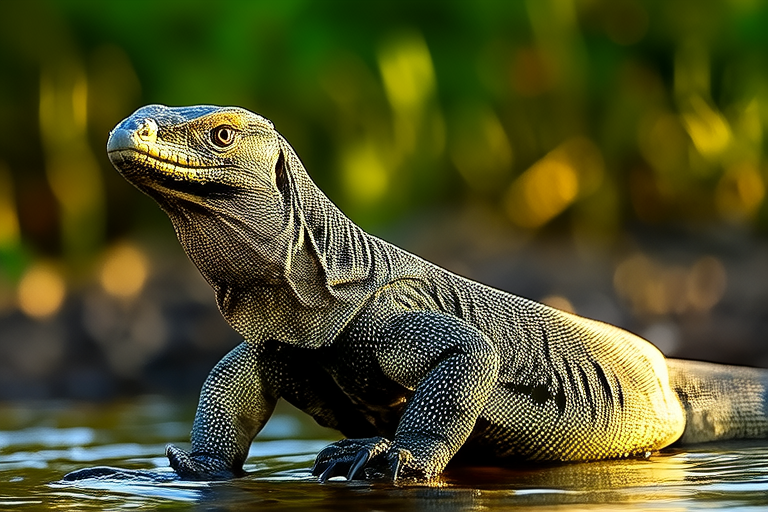Unleashing the Secrets of the Water Monitor: Nature’s Aquatic Wonder
The water monitor (Varanus salvator) is a true marvel of the animal kingdom, standing out as one of nature’s most versatile reptiles. Known for its exceptional adaptability to both terrestrial and aquatic environments, this species has captured the fascination of wildlife enthusiasts and scientists alike. With its impressive size, striking color variations, and distinct physical features, the water monitor is a testament to the wonders of evolution.
Physical Characteristics
Water monitors are large lizards, with males typically reaching lengths of up to 3 meters, although some individuals can grow even larger. Their bodies are covered in scales that vary in color from olive green to brown, often with yellow or cream-colored markings. These colorations help them blend into their surroundings, providing excellent camouflage against predators. The water monitor’s powerful limbs are equipped with sharp claws, perfect for digging burrows, climbing trees, and capturing prey. One of the most distinctive features of this reptile is its long, muscular tail, which not only serves as a propeller for swimming but also aids in balance and defense.
Habitat and Distribution
These lizards are found throughout Southeast Asia, ranging from India to Indonesia, and have also been introduced to parts of Africa and the Caribbean. They thrive in a variety of habitats, including mangrove swamps, rivers, lakes, and coastal areas. Water monitors are highly adaptable and can be found in both freshwater and saltwater environments, making them one of the few reptiles capable of living in such diverse conditions.
Diet and Hunting Techniques
The water monitor is an opportunistic feeder, with a diet that includes a wide range of animals. Their menu consists of fish, amphibians, small mammals, birds, insects, and even carrion. They are skilled hunters, employing various techniques depending on the type of prey. In water, they use their keen eyesight and sense of smell to locate fish and other aquatic creatures. On land, they rely on their speed and agility to chase down smaller animals. When hunting, water monitors can be relentless, often subduing prey through constriction or biting.
Social Behavior and Ecosystem Interactions
While water monitors are generally solitary animals, they do exhibit some social behaviors. Males are known to engage in combat during the breeding season, competing for the attention of females. Despite their solitary nature, water monitors play a crucial role in their ecosystems. As apex predators, they help control populations of smaller animals, contributing to the overall health and balance of their habitats.
Common Misconceptions
One of the most common misconceptions about water monitors is that they are dangerous to humans. While they can deliver a painful bite if provoked, they are generally not aggressive towards people. Another misconception is that they are venomous. Although they have glands near their teeth that secrete a mild toxin, it is not considered harmful to humans. Understanding these facts helps dispel unnecessary fears and encourages respectful coexistence with these magnificent creatures.
Conservation Efforts
The water monitor faces several threats, including habitat destruction, illegal pet trade, and overhunting for their skin and meat. Conservation efforts are underway to protect these reptiles and their habitats. Organizations and governments are working together to establish protected areas, enforce stricter regulations on the pet trade, and educate local communities about the importance of preserving these animals. Public awareness campaigns also play a vital role in changing attitudes and promoting responsible wildlife tourism.
Importance of Understanding and Preserving the Species
Understanding and preserving the water monitor is crucial for maintaining ecological balance. By studying their behavior, diet, and habitat preferences, researchers can gain valuable insights into the broader ecosystem dynamics. Protecting these reptiles ensures the continued health of their environments, benefiting not only the water monitors themselves but also countless other species that depend on these habitats. Furthermore, the water monitor serves as a symbol of the resilience and adaptability of life, reminding us of the importance of biodiversity and the interconnectedness of all living things.
In conclusion, the water monitor is a remarkable example of evolutionary adaptation, showcasing the incredible diversity of life on our planet. By appreciating and protecting this species, we contribute to the preservation of natural ecosystems and ensure that future generations can continue to marvel at the wonders of nature. Let us embrace our role as stewards of the environment and work together to safeguard the water monitor and its habitats for years to come.
